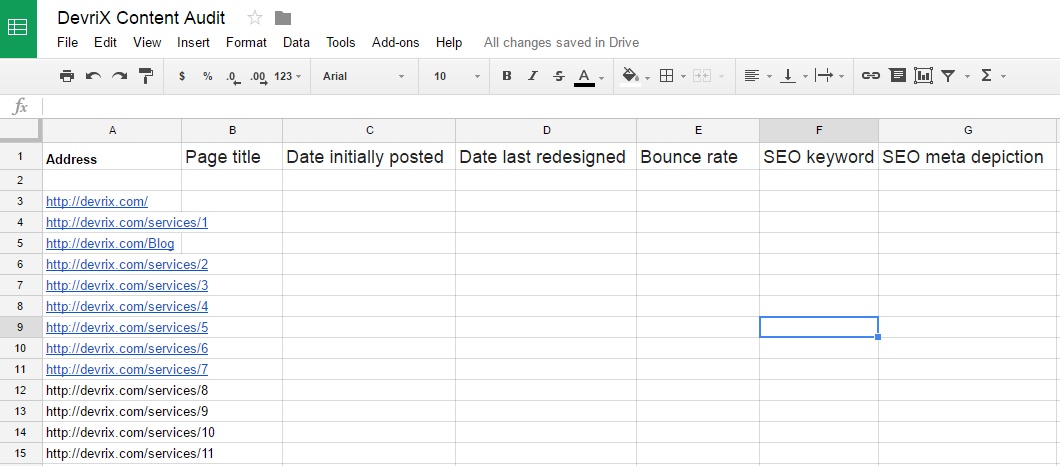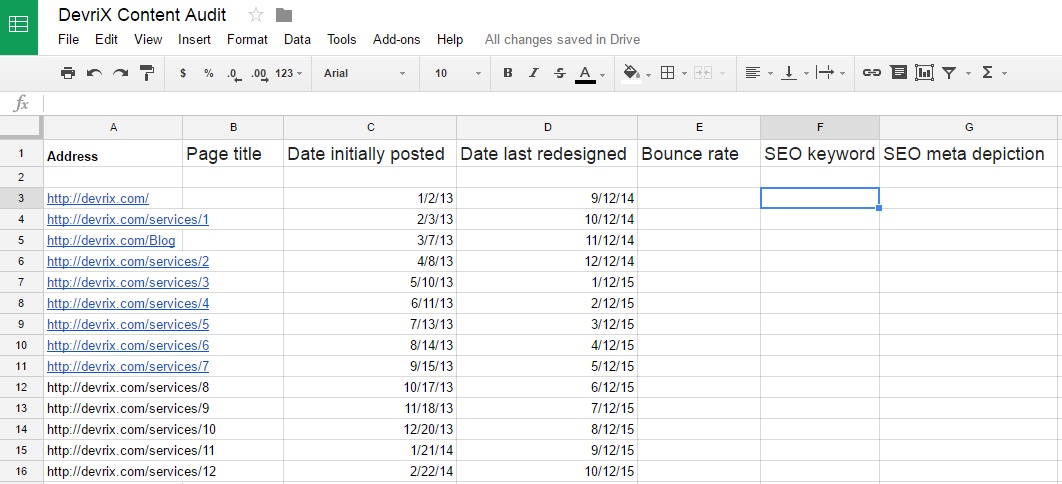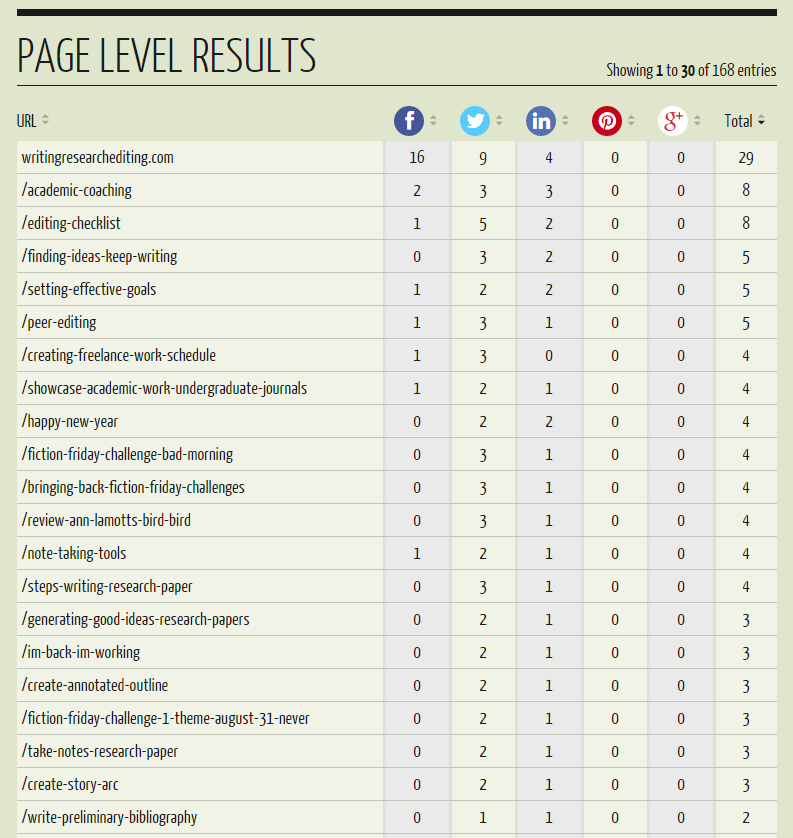Are you struggling to understand the behavior of your visitors on your site?
Are your marketing initiatives working properly? If not, then why?
Before we get into the step-by-step process of leading a content audit, let’s discuss some basics.
What is a Website Content Audit?

A content audit involves reviewing and analyzing all the content on your site – blog posts, landing pages, videos, testimonials, ect., so you can collect insights about what to create, update and remove. This way, you can not only identify areas which are not correctly optimized for search engine rank – like meta descriptions, but you can also discover new SEO opportunities to leverage – like adding keywords to headings.
The more knowledge search engines have about the content on your website the better they will be able to rank it, and therefore suggest your pages to users more accurately. In fact, conducting a website content audit gives you the chance to update your site’s copy in all the right areas so that the information is up-to-date and the readers can easily comprehend it and interact with it.
There are a few ways to approach auditing your site’s content, and the three main types of audit are:
- Full Content Audit. A comprehensive analysis of every content on the site. This may incorporate all pages, call-to-actions, downloadables, etc.
- Halfway Content Audit. An analysis of a subset of your site’s content. A halfway audit may incorporate the main pages of your site or all blog content posted over the last six months.
- Content Sample. A brief analysis of selected content from your site.
What Goes Into An Effective Content Audit?
When you have a considerable amount of content on your site, reviewing it will be quite time-consuming. However, it’s a very important task to undertake to ensure that none of your content efforts go in vain.
To begin, you will need to identify the pages you want to analyse and then create a spreadsheet that includes all important details.. Make sure to include the following sections:
- Title.
- Date InitiallyPosted.
- URL.
- Date Last Updated.
- Content Proprietor. – Who is the author of the content? Who is in charge of upgrading the content?
- Content Files. – Documents connected with the page – What pictures or downloads are connected with the page? Are there isolated measurements for them?
- Total Time. How long did it take to create the content?
- Content Type. Is the content a case study, an infographic, an ebook, etc?
- Content Goal. What was the reason for creating the content: traffic, backlinks, conversions?
- Word Count. How long should the content be to perform the best?
- Keywords. – What are the primary and secondary keywords for each page?
- Meta Description. How is the page optimized for internet search? Does it include a description of what the content is about?
- Site Visits. How many users read your content for the past six months to one or two years?
- Bounce Rate. – What number of individuals leave the page in 10 seconds or less?
- Comments. What did the readers like/dislike about the content?
- Shares. How many people shared your content and on what platform?
Reasons to Conduct a Content Audit
Normally, there are two main reasons to conduct a content audit:
- SEO. Running a content audit can help you recognize any frail spots in your site’s SEO. By reviewing titles, headings, keywords, image alt tags, backlinks and all the different components on your site, you would be able to get an idea about what changes you should make to enhance your site’s ranking.
- Content Marketing. Another great reason to conduct a content audit is to evaluate the effectiveness of your content marketing strategy. For example, by focusing on things like page length, visits metrics, and social shares you would be able to get insights on how users react to and engage with every content piece you’ve made and, subsequently, how you should modify your marketing efforts later on.
These two reasons, while described separately, are not completely isolated from one another. Both SEO and content marketing are very important for your online success, and when combined effectively they can help ensure great visibility for your site and business.
How to Conduct a Content Audit?
We mentioned that performing a website content audit is a complex process, so to make it a little more simple we have broken it down into three main steps.
Here is how to audit your content in three steps:
Step #1: Make a Spreadsheet of Your Content Resources
Obviously, the initial phase of a content audit is to organize all your content in a single file. For this, you can use a tool like Screaming Frog to distinguish every one of the URLs on your current site or you can physically enter the URLs into your spreadsheet yourself. Remember that you’ll be recording different metrics for every URL you’re following, so duplicating and sticking them one by one doesn’t really take any longer than using a dedicated tool.
Step #2: Gather Information Depending on Your Goals
Before you start analyzing all the data you have collected, you need to be clear about what you want to accomplish. Once you have clear goals in mind, it will be much easier to categorize your audit later.
In essence, the purpose of a content audit is to find engaging content that can be further optimized for search engines and conversions. Therefore, one of your audit goals could be to evaluate which pages on your website are SEO optimized. Alternatively, you may want to find the best performing content you have and place it on your homepage, and/or a relevant landing page, or include it in your newsletter.
By establishing clear goals for your website content audit, you will be able to ensure better bookkeeping of all your materials and update your SEO and content marketing strategy faster.
Step #3: Analyze Your Information
In the event that your site has a lot of content, expect the information gathering process to take quite a while. When this is the case, it’s normal for audits to take days, weeks or even months to finish. The pace depends on the size of the site and the authoritative assets that are accessible for the procedure.
However, even if there’s a chance that your content analysis is completed faster than expected you will still have another vital task to undertake – really putting your data to use!
In other words, you need to plan what your next moves will be once the content audit is finished. For example, on the one hand, you can refresh old content with some new information, or delete it altogether. On the other hand, if you have introduced a new workflow of creating and structuring content then you can re-write and restructure older pieces to match your new style.
Whatever actions you decide to take should be in sync with your goals and intended to improve your overall SEO and content marketing strategies.
Useful Free Tools for Auditing Your Content
Quick Sprout
Quick Sprout is a good tool for individuals who need to dissect SEO on their sites. You will get an SEO Score on how well you’ve dealt with every page and proposals for enhancing your site. You’ll need to give careful consideration to anything that is in blunder and those things for which you’ve gotten a warning.
XML Sitemap Generator
The XML Sitemap Generator is a powerful tool that will slither your site and make a computerized sitemap of up to 50,000 URLs and up to 10 megabytes. This will get any of the pages that you may have overlooked, pull up any old occasion pages, and permit you to just include the pages it thinks of into a spreadsheet.
HTTrack Website Copier
HTTracker is another free desktop application that rearranges the entire procedure of thinking of your site outline. It permits you to download your site to a nearby catalog, pulling the site together piece by piece.
Kapost
Kapost has a free audit program that can rearrange your examination procedure. The program slithers through your site and pulls up the majority of the page joins from it. While this application takes more time to keep running than the others in this list, it’s justified regardless of an ideal opportunity to look at it.
You can spare your substance review, which is a decent reward, or you can download the review as a CSV document that as of now has a portion of the segments you’ll require for your review.
The apparatus additionally gives you tips on how you can reinforce your substance notwithstanding a helpful reference for directing your review.
SEO Spider
SEO Spider is a desktop application introduced specifically for PCs. It is good with Windows, Mac, and Linux working frameworks.
The program’s free form will just creep 500 URLs. In any case, on the off chance that you have a littler site you wish to deal with, the free form might be all that you require. Rather than compiling titles and URLs into a program all alone, this program will make an Excel archive for you that has large portions of the key SEO bits of knowledge important for a content audit.
Bottom Line
Now you know everything there is about how to audit your content. However, remember that you don’t exist in an air pocket! How your content performs greatly depends on how well it’s optimized for search engines and if it resonated with your audiences well.
Additionally, conducting a content audit will enable you to spot SEO opportunities and keep your competitive edge. This way, you will be able to effectively engage your target audience and encourage them to convert.









![6 Ways to Strengthen Your B2B Content Marketing Strategy [Part 1]](https://devrix.com/wp-content/uploads/2019/12/6-Ways-to-Strengthen-Your-B2B-Content-Marketing-Strategy-Part-1@2x-380x160.png)